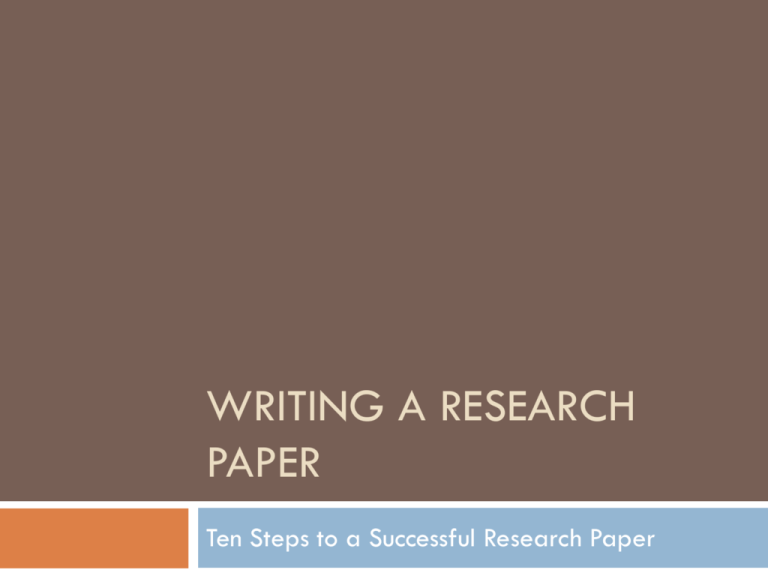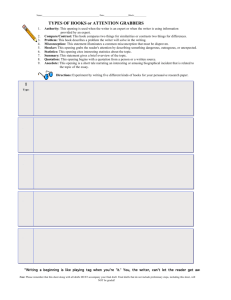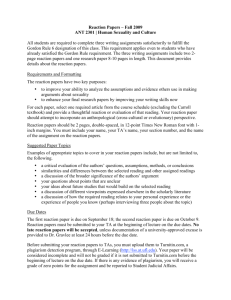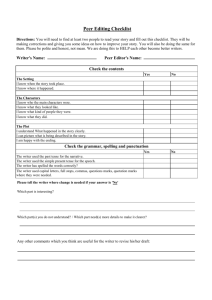Research Paper PowerPoint
advertisement

WRITING A RESEARCH PAPER Ten Steps to a Successful Research Paper Step One: Choosing a Topic A workable topic should meet the following requirements: You can find enough material on the topic. Usually, that means you can find at least five diverse topics. The topic interests you, and you think you can make it interest your audience. Ask yourself if you would like to become the class “expert” on this topic. Take an interest inventory. Take stock of things you are interested in. List as many as possible. Look for topic ideas. Explore many sources such as newspapers, magazines, and the internet for paper topics. Refining your Topic The topic is objective, not subjective. Objective = Factual Example: Objective: Evidence for and against side airbags in cars Subjective: My uncle’s car accident The topic is limited enough to be covered adequately in the space available. Example: Too General: Ants Still Too General: Fire Ants Still Too General: The evolution of fire ants Just Right: The invasion of fire ants in the U.S. Too Limited: What to do if you are stung by a fire ant Too Limited: What a fire ant looks like When browsing online remember… If you enter a general topic, like karate, a search engine will provide hundreds or thousands of listings. From those you might be able to narrow your search by selecting a more specific topic such as these: History of karate Training and equipment Rules and etiquette How it differs from other martial arts USA Karate Foundation Karate competitions Word your limited topic as a research question to investigate. Before you explore, jot down what you already know about your topic. Be as specific as possible. Afterward, think about questions you would like to have answered about your topic. Your topic selection should end with one focused research question to guide your work. Examples: How did Langston Hughes come to invent the blues poem? How has Relay for Life improved cancer research and helped to find a cure? Practice Exercise 4 Exercise 7 Choosing your Topic Exercise 9 Step Two: Locate Sources Primary Sources: original text, document, interview, speech, or letter. This is NOT someone’s comments on or an analysis of a text; it is the text itself. Example: U.S. Census data Secondary Sources: not an original text or document. This is someone’s comments on or analysis of a primary source. Example: A study of economic trends based on census data Evaluate Sources Check the date: You want accurate, up-to-date information. Check the author. Is the writer an expert on the topic? Can you find some information about the writer? Where should you start? Library: encyclopedias, biographical information, almanacs, quotations, specialized books on the subject, newspaper and magazine articles, etc. Internet: Evaluate Internet Sources Carefully Don’t believe everything you read on the internet! Who wrote the web page? Usually, you can find the name. How qualified are they? How accurate is the information? Can you verify the same information in other sources? How up-to-date is it? Check to see when it was last updated. Is the information biased? Bias can be hard to detect. Exaggeration, name-calling, and stereotyping are clues that the site is biased. Practice Online Tutorial: Parts 1-3 Exercise 1 Exercise 2 Exercise 3 Hint: Not every source you explore will have useful information. Don’t waste time reading a source slowly or taking notes once you have decided the source isn’t useful. Bibliography Cards: Keeping Track of Sources Keep track of each source you use. Record the author, title, and publishing information. For each card you will want to add your own notes or comments about the information. We will be using MLA (Modern Language Association) style of documentation. OWL Purdue Online OWL MLA Guide Citation Machine OneNote Option Mrs. Thompson’s English IV Notebook What is wrong with each entry? Ralph Hickok. A Who’s Who of Sports Champions. Houghton Mifflin, New York, 1995. Editor, Jeff Silverman. Text by Lardner, Ring. Lardner on Baseball. 2002, Lyons Press in Guilford, CT. Allende, Isabel. Paula. Translated by Margaret Sayers Peden. 1994, Harper Collins: New York. Continue Practicing Isaac Victor Kerlow. The Art of 3D: computer Animation and Effects, Third edition. Hoboken, NJ, John Wiley & Sons. 2004. 3rd edition. Glanz, James, “Uut and Uup Add Their Atomic Mass to Periodic Table” in New York Times, a newspaper, February 1, 2004, page 1 southern edition, section YT. Kennedy, Joseph. “The Wild Man of Samoa.” Natural History, a magazine. Feb. 2004. Pages 22-25, 66. Create an MLA Citation for Each Source National Audubon Society Field Guide to the Night Sky Alfred A. Knoph, publisher, New York Author Mark R. Chartrand Copyright 1991 Library of Congress Cataloging Number 9152708 http://www.astro.wisc.e du/~dolan/constellation s/extra/constellations.ht ml Correct Citations: Chartrand, Mark R. National Audubon Society Field Guide to the Night Sky. New York: Alfred A. Knoph, 1991. Print. Dolan, Chris. "What are Constellations?." The Stars and Constellations. University of Wisconsin, n.d. Web. 18 Feb 2011. <http://www.astro.wisc.edu/~dolan/ constellations/ extra/constellations.html>. Step 3: Take Notes If you do a good job taking notes, all the rest of the steps in writing your paper will be much easier. However, if you do not take care to record and credit your sources fully and accurately, you will make more work for yourself later. Make a Working Outline This is your road map to see where you are headed. Use these questions to guide your work. What are my research questions? What do I want answers to? What are the most important ideas? What background information will readers need? What are the main parts, sections, of my paper, and how do they relate to one another? How might I best organize the information? What conclusions do I expect to draw? Sample Outline What an Impact Focus Question: How has the Susan B. Komen Foundation impacted breast cancer research? Thesis Statement: The work of the Komen Foundation has impacted awareness and funding for a cure. I. Introduction II. Increased Awareness A. How has it increased awareness? i. media ii. personalities B. What has increased awareness meant to the general population? i. increased public support ii. earlier detection in women III. More Funding A. What types of funding activities are utilized? B. Where is the money going? C. What outcomes are evident from the additional money? IV. Conclusion Avoiding Plagiarism There are basically two kinds of plagiarism: intentional and accidental. You must not copy the words or ideas of another writer without giving them credit. You cannot even come close to copying. Plagiarism is a serious academic offense and carries serious consequences. Plagiarism Online Tutorial: Parts 1-3 Video Three Kinds of Notes Direct Quotation: Copy the quote exactly, word for word, just as the writer wrote it, and enclose the quoted material in quotation marks. Paraphrasing: Restate the writer’s own ideas in your own words. Generally you paraphrase a shorter text and cover every idea in the same order as the writer. Summarizing: Restate the main ideas of a text in your own words. A summary does not give all the details, only the most important. How should you paraphrase this text? Example: Original Text & Citation Students frequently overuse direct quotation in taking notes, and as a result they overuse quotations in the final research paper. Probably only about 10% of your final manuscript should appear as directly quoted matter. Therefore, you should strive to limit the amount of exact transcribing of source materials while taking notes. Lester, James D. Writing Research Papers. 2nd ed. (1976): 46-47. Sample Answers Legitimate Paraphrase In research papers students often quote excessively, failing to keep quoted material down to a desirable level. Since the problem usually originates during note taking, it is essential to minimize the material recorded verbatim (Lester 46-47). Acceptable Summary Students should take just a few notes in direct quotation from sources to help minimize the amount of quoted material in a research paper (Lester 46-47). Work Cited Goldenberg, Phyllis. Writing a Research Paper: A Step-by-Step Approach. William H. Sadlier, Inc., 2005.






